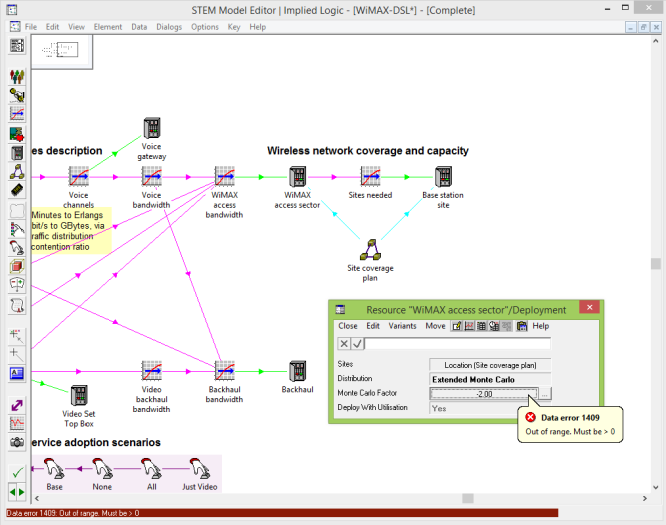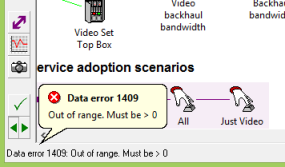-
 Select Check for Errors from the File menu or select the Check for errors button on the toolbar. The model data is checked and STEM compiles a list of any errors. If there are none, the message
No data errors
is displayed in the status bar of the main Editor window. Otherwise, the Editor displays the data dialog which contains the source of the error and highlights the relevant field, with an error message displayed in a standard error or warning tooltip, right next to the field in question. An explanation of the problem is also displayed in the status bar, which flashes to draw your attention to it.
Select Check for Errors from the File menu or select the Check for errors button on the toolbar. The model data is checked and STEM compiles a list of any errors. If there are none, the message
No data errors
is displayed in the status bar of the main Editor window. Otherwise, the Editor displays the data dialog which contains the source of the error and highlights the relevant field, with an error message displayed in a standard error or warning tooltip, right next to the field in question. An explanation of the problem is also displayed in the status bar, which flashes to draw your attention to it.

Figure 1: Finding an error in a STEM model
- As soon as you start to enter a correction, the tooltip moves down to the status bar. The solution to the correction might require changes to fields other than the one which generated the error.

Figure 2: An example of an error tooltip on the status bar
 Select Next Error from the File menu or select the Show next error button on the toolbar. The Editor displays the data dialog containing the source of the next error in the compiled list.
Select Next Error from the File menu or select the Show next error button on the toolbar. The Editor displays the data dialog containing the source of the next error in the compiled list.
- Repeat steps 2 and 3 until the status bar message reads No more errors.
At any stage during this process, you can:
- select Previous Error from the File menu (or select the Show previous error button on the toolbar) to move back to the previous field, or
- select Check for Errors from the File menu (or the Check for errors button on the toolbar) to start checking afresh.
The sorts of problems that STEM will detect at this stage include:
- divide-by-zero errors in formulae, which can be caused by separate numeric inputs referenced in a formula being changed after a formula has been defined
- circular references in formulae
- invalid or missing external references, which can be caused by changes made to external files after a formula has been defined
- inputs completely out of range, e.g., negative Penetration for a service
- inconsistent inputs, e.g., Financial Lifetime > Physical Lifetime for a resource
- circular chains of demand, e.g., a Resource transformation indirectly mapping demand onto the corresponding resource.
For help on more complicated errors, see 4.22.2 Simpler language and help on errors.